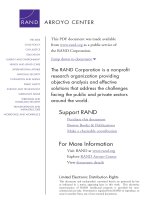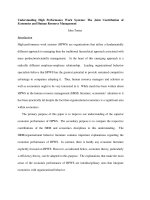HUman resource managemenr 2e s keiman chapter2
Bạn đang xem bản rút gọn của tài liệu. Xem và tải ngay bản đầy đủ của tài liệu tại đây (224.54 KB, 31 trang )
Chapter 2
Understanding the Legal and
Environmental Context of HRM
© 2010 Cengage Learning. Atomic Dog is a trademark used herein under license. All rights reserved.
Chapter Outline
•
2-1 Legal Issues in the Workplace
•
2-2 Environmental Issues in the Workplace
© 2010 Cengage Learning. Atomic Dog is a trademark used herein under license. All rights reserved.
2-1 Legal Issues in the Workplace
•
HRM laws address:
Specific employment practices.
Broader issues such as employment discrimination,
safety, privacy, and employees’ rights to due process.
© 2010 Cengage Learning. Atomic Dog is a trademark used herein under license. All rights reserved.
2-1a Equal Employment Opportunity
•
Passed by Congress in the 1960s.
•
Designed to eradicate employment discrimination
based on race, color, sex, religion, national origin,
age, and disability; these categories are referred to
as protected classifications.
•
Protected groups are sub-categories of people within
each protected classification.
© 2010 Cengage Learning. Atomic Dog is a trademark used herein under license. All rights reserved.
© 2010 Cengage Learning. Atomic Dog is a trademark used herein under license. All rights reserved.
2-1a Equal Employment Opportunity
(cont.)
•
Civil Rights Act of 1964 (Title VII): Entitles victims to
relief in the form of legal costs and back pay.
•
Civil Rights Act of 1991: Addresses the issue of
mixed-motive cases, in which employment decision is
partly on a legitimate motive and partly on a
discriminatory one.
•
Pregnancy Discrimination Act of 1978
•
Immigration Reform and Control Act of 1986
•
Age Discrimination in Employment Act of 1967
•
Genetic Information Nondiscrimination Act (2008)
© 2010 Cengage Learning. Atomic Dog is a trademark used herein under license. All rights reserved.
2-1a Equal Employment Opportunity
(cont.)
•
Americans with Disabilities Act of 1990 (Title I)
An individual is considered disabled if a physical or
mental impairment “substantially limits” one or more
major life activities.
To win a complaint, an individual must establish that,
with accommodation, he or she is qualified to perform
the essential functions of the job.
The employer must prove that the candidate is unable
to perform the job satisfactorily even with reasonable
accommodation or that the reasonable
accommodation would impose “undue hardship.”
© 2010 Cengage Learning. Atomic Dog is a trademark used herein under license. All rights reserved.
2-1a Equal Employment Opportunity
(cont.)
•
Two types of discrimination:
Intentional discrimination or disparate treatment
-
Treating people unfairly based on their membership in a
protected group.
May also occur as the result of trying to ‘‘protect’’ the
group members’ interests.
Unintentional discrimination or disparate impact
-
Any practice without business justification that has
unequal consequences for people of different protected
groups.
© 2010 Cengage Learning. Atomic Dog is a trademark used herein under license. All rights reserved.
2-1a Equal Employment Opportunity
(cont.)
•
Discrimination and the courts
The plaintiff must establish a prima facie case of
discrimination.
To establish a prima facie case, the plaintiff must
present evidence that makes the employer’s actions
appear discriminatory.
When a plaintiff establishes a prima facie case, the
burden shifts to the employer to rebut the case by
presenting evidence that justifies the fairness of its
actions.
© 2010 Cengage Learning. Atomic Dog is a trademark used herein under license. All rights reserved.
2-1a Equal Employment Opportunity
(cont.)
•
Establishing a prima facie case of intentional
discrimination
Restricted company policy: Plaintiff proves that the
company has a formal policy that restricts the selection
of a protected group.
Discriminatory remarks: Plaintiff must produce
evidence that certain biased remarks were made by
the employer regarding the protected group.
© 2010 Cengage Learning. Atomic Dog is a trademark used herein under license. All rights reserved.
2-1a Equal Employment Opportunity
(cont.)
•
Establishing a prima facie case of intentional
discrimination – McDonnell-Douglas test:
Used to infer the presence of discriminatory intent
when more direct evidence of discrimination is lacking.
Requires the plaintiff to show that he or she:
-
Belongs to the protected group in question.
Has applied for and is qualified for the job for which the
employer was seeking applicants.
Was rejected.
After rejection, the position remained open or was filled
by someone who was not a member of that protected
group.
© 2010 Cengage Learning. Atomic Dog is a trademark used herein under license. All rights reserved.
2-1a Equal Employment Opportunity
(cont.)
•
Establishing a prima facie case of unintentional
discrimination – The four-fifths rule:
Helps determine whether between-group differences in
hiring rates are large enough to be important.
Is calculated by comparing the hiring rate of the
“disadvantaged” protected group with the rate of the
“advantaged” group.
A prima facie case of discrimination is established
when the hiring rate of the former group is less than
four-fifths of the latter group.
© 2010 Cengage Learning. Atomic Dog is a trademark used herein under license. All rights reserved.
2-1a Equal Employment Opportunity
(cont.)
•
Rebutting a prima facie case of intentional
discrimination
Restricted company policy
-
When the employer has a policy that excludes an entire
protected group, it uses the BFOQ defense.
BFOQ refers to "bona fide occupational qualification.”
The employer argues that it purposely discriminated
against all members of a group for reasons including all
or nearly all, authenticity, propriety, and safety.
Discriminatory remarks: Requires the employer to
argue that the remarks were not very derogatory or
that the person who made the remarks had no
influence on the hiring decision.
© 2010 Cengage Learning. Atomic Dog is a trademark used herein under license. All rights reserved.
2-1a Equal Employment Opportunity
(cont.)
•
Rebutting a prima facie case of intentional
discrimination – The McDonnell-Douglas test
Employer must present evidence showing that its
employment decision was based on legitimate,
nondiscriminatory reasons.
The plaintiff could still win the case if they prove that
the reason offered by the employer was merely a
pretext or an excuse; the “real” reason for the action
was discrimination.
© 2010 Cengage Learning. Atomic Dog is a trademark used herein under license. All rights reserved.
2-1a Equal Employment Opportunity
(cont.)
•
Rebutting a prima facie case of unintentional
discrimination – The four-fifths rule
A firm must demonstrate that the procedure in
question is a business necessity.
According to the CRA of 1991, when several selection
devices are used, only those causing the disparate
impact must be justified.
The exception to this rule occurs when the elements of
a respondent’s decision-making process are not
capable of separation for analysis; the decisionmaking process may be analyzed as one employment
practice.
© 2010 Cengage Learning. Atomic Dog is a trademark used herein under license. All rights reserved.
2-1b Affirmative Action
•
Affirmative action programs aim to redress past
discrimination against protected classes and correct
racial and gender imbalances in the workforce.
•
It attempts to accomplish this aim through initiatives
that are ‘‘color-conscious.’’
•
Most firms are under no obligation to implement
affirmative action programs.
© 2010 Cengage Learning. Atomic Dog is a trademark used herein under license. All rights reserved.
2-1b Affirmative Action (cont.)
•
Firms voluntarily implementing affirmative action
believe that they can:
Attract and retain a larger and better pool of
applicants.
Create a more diverse workforce.
Avoid discrimination lawsuits.
Improve the firm’s reputation within the community and
its consumer base.
© 2010 Cengage Learning. Atomic Dog is a trademark used herein under license. All rights reserved.
2-1b Affirmative Action (cont.)
•
Affirmative action is implemented through two
primary steps:
Utilization analysis
Developing an affirmative action plan (AAP)
© 2010 Cengage Learning. Atomic Dog is a trademark used herein under license. All rights reserved.
2-1b Affirmative Action (cont.)
•
Utilization analysis
A statistical procedure that compares the percentage
of each protected group for each job category within
the organization to that in the available labor market.
If the organizational percentage is less than the labor
market percentage, the group is classified as being
“underutilized.”
© 2010 Cengage Learning. Atomic Dog is a trademark used herein under license. All rights reserved.
2-1b Affirmative Action (cont.)
•
Affirmative action plan (AAP)
Affirmative action plans target the underutilized
protected groups.
An AAP is a written statement that specifies how the
organization plans to increase the utilization of
targeted groups.
The AAP consists of three elements – goals,
timetables, and action steps.
An AAP practice sometimes involves the use of
preferential treatment.
© 2010 Cengage Learning. Atomic Dog is a trademark used herein under license. All rights reserved.
© 2010 Cengage Learning. Atomic Dog is a trademark used herein under license. All rights reserved.
2-2 Environmental Issues in the
Workplace
•
Cultural diversity
•
The changing nature of work
•
Mergers and takeovers
•
Corporate downsizing
© 2010 Cengage Learning. Atomic Dog is a trademark used herein under license. All rights reserved.
2-2a Cultural Diversity in the Workplace
•
To manage diversity effectively, an organization must
be sensitive to the needs of new workers and seek to
identify and eliminate barriers, if any.
•
Diversity training makes employees aware of their
biases regarding minority groups and teaches them
ways to overcome those biases.
© 2010 Cengage Learning. Atomic Dog is a trademark used herein under license. All rights reserved.
2-2a Cultural Diversity in the Workplace
(cont.)
•
Breaking the “glass ceiling” – Helping minorities and
women reach their career goals, and implementing
promotion procedures that are less subject to bias.
•
Meeting the needs of older employees –
Compensating for their diminishing skills, and placing
them on jobs relying less on physical prowess and
more on maturity and experience.
•
Implementing work and family programs –
Introduction of nontraditional work arrangements
such as telecommuting, flextime, and job sharing.
© 2010 Cengage Learning. Atomic Dog is a trademark used herein under license. All rights reserved.
2-2a Cultural Diversity in the Workplace
(cont.)
•
Telecommuting: A nontraditional work arrangement in
which employees work at home.
•
Limitations of telecommuting include lack of
supervision and unavailability for meetings.
•
Flextime: Setting up a flexible work schedule in which
workers put in their eight hours each day but choose
their starting and ending times.
•
Job sharing: An alternate work schedule in which a
full-time job is shared by two people.
© 2010 Cengage Learning. Atomic Dog is a trademark used herein under license. All rights reserved.




![audio engineering 101 [electronic resource] a beginner's guide to music production](https://media.store123doc.com/images/document/14/y/ii/medium_iij1401381447.jpg)
![broken markets [electronic resource] a user's guide to the post-finance economy](https://media.store123doc.com/images/document/14/y/kz/medium_kzd1401381668.jpg)
![ios sdk programming [electronic resource] a beginner's guide](https://media.store123doc.com/images/document/14/y/ph/medium_phw1401472929.jpg)


